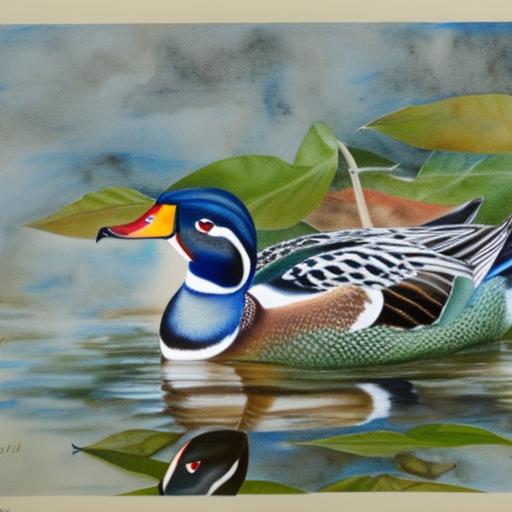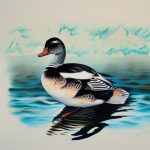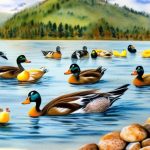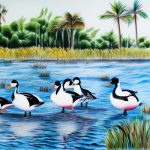The American Wood Duck, scientifically known as Aix sponsa, is a stunningly beautiful and colorful bird that is native to North America. It is a medium-sized perching duck that is known for its distinctive iridescent plumage and unique courtship displays. The wood duck is a popular subject for birdwatchers and wildlife enthusiasts due to its striking appearance and interesting behaviors. These ducks are commonly found in wooded swamps, marshes, and shallow lakes across the eastern United States and parts of Canada. They are also known for their strong flying abilities and can be seen migrating to different regions during the winter months.
The wood duck is a highly sought-after species for hunters and has been the focus of conservation efforts due to declining populations in the past. However, through successful conservation programs and habitat restoration, the wood duck population has rebounded in recent years. These efforts have helped to ensure the survival of this iconic species for future generations to enjoy. In this article, we will explore the physical characteristics, breeding behavior, nesting habits, parental care, and conservation status of the American Wood Duck.
Key Takeaways
- The American Wood Duck is a colorful and unique species of waterfowl found in North America.
- Male wood ducks have striking physical characteristics, including iridescent green and purple head feathers and red eyes.
- Breeding behavior and courtship displays of wood ducks involve elaborate rituals and vocalizations to attract mates.
- Female wood ducks nest in tree cavities and lay around 10-15 eggs, which they incubate for about a month.
- Wood duck parents provide extensive care for their offspring, including leading them to water and protecting them from predators.
Physical Characteristics of the Male Wood Duck
The male wood duck is renowned for its vibrant and colorful plumage, making it one of the most visually striking waterfowl species in North America. The male wood duck has a distinctive iridescent green and purple head with a white throat and bright red eyes. Its chest is adorned with intricate white and black patterns, while its sides are marked with bold vertical white stripes. The back and wings of the male wood duck are a rich chestnut brown, and its tail feathers are long and pointed, adding to its overall elegance.
In addition to its stunning plumage, the male wood duck also has a unique crest on its head that can be raised or lowered depending on its mood or level of excitement. This crest adds to the bird’s overall regal appearance and makes it easily recognizable in the wild. The male wood duck’s physical characteristics play a crucial role in attracting mates during the breeding season, as females are drawn to males with the most vibrant and attractive plumage. Overall, the male wood duck’s physical appearance is a testament to the beauty and diversity of wildlife in North America.
Breeding Behavior and Courtship Displays
During the breeding season, male wood ducks engage in elaborate courtship displays to attract females and establish mating pairs. These courtship displays often involve the male showcasing its vibrant plumage and performing intricate movements to impress potential mates. One of the most iconic courtship displays of the male wood duck is the “head-throwing” behavior, where the male rapidly throws its head back over its body while emitting a soft whistle-like call. This behavior is often accompanied by wing-flapping and tail-raising, creating a mesmerizing spectacle for onlookers.
In addition to head-throwing, male wood ducks also engage in “bobbing” displays, where they rhythmically dip their heads up and down while emitting soft calls to attract females. These courtship displays are not only visually stunning but also serve as a way for males to establish dominance and attract the attention of potential mates. Female wood ducks are known to be selective when choosing a mate, often favoring males with the most vibrant plumage and impressive courtship displays. These behaviors play a crucial role in the reproductive success of wood ducks and contribute to the overall health of their populations.
Nesting and Egg-laying
After mating pairs have been established, female wood ducks begin searching for suitable nesting sites to lay their eggs. Wood ducks are cavity nesters, meaning they seek out natural tree cavities or man-made nest boxes to build their nests. These nests are typically lined with down feathers from the female’s breast to provide insulation and protection for the eggs. Female wood ducks are known for their meticulous nest-building skills, often spending several days carefully arranging nesting materials to create a safe and comfortable environment for their eggs.
Once the nest is complete, female wood ducks lay an average of 10-15 eggs over a period of several days, with one egg being laid each day. The eggs are creamy white in color and are about the size of a chicken egg. After all the eggs have been laid, the female begins the incubation process, which lasts for approximately 28-30 days. During this time, the female diligently tends to her eggs, turning them regularly to ensure even heat distribution and protection from predators. The nesting period is a critical time for wood ducks, as it determines the survival of their offspring and contributes to the overall success of their breeding season.
Parental Care and Offspring
Once the eggs hatch, the female wood duck leads her brood of ducklings from the nest to nearby water sources within 24 hours. The ducklings are precocial, meaning they are born with their eyes open and are capable of walking and swimming shortly after hatching. The female provides guidance and protection for her ducklings as they navigate their new environment, teaching them essential skills such as foraging for food and avoiding predators.
Male wood ducks do not typically participate in parental care, as they may mate with multiple females during the breeding season and focus on attracting new mates. This places the responsibility of raising and protecting the offspring solely on the female. However, female wood ducks are highly dedicated mothers and will fiercely defend their brood from potential threats, including predators and other waterfowl. The bond between mother and ducklings is strong, and the female will continue to care for her offspring until they are old enough to fend for themselves.
Conservation Status and Threats

The American Wood Duck has faced several threats to its population over the years, including habitat loss, hunting pressure, and competition from invasive species. However, through successful conservation efforts and habitat restoration programs, the wood duck population has shown signs of recovery in recent decades. Conservation organizations have worked tirelessly to protect critical wetland habitats and establish nesting boxes to provide safe breeding sites for wood ducks.
Despite these positive trends, ongoing threats such as habitat degradation, pollution, and climate change continue to pose challenges for wood duck populations. Wetland loss due to urban development and agricultural expansion remains a significant concern for these birds, as it directly impacts their ability to find suitable nesting sites and food sources. Additionally, hunting pressure can still impact wood duck populations in certain regions, highlighting the need for sustainable management practices and regulations to ensure their long-term survival.
Conservation efforts for the American Wood Duck have been successful in many areas, but continued research and monitoring are essential to understand the full scope of threats facing these birds and develop effective strategies for their protection. By raising awareness about the importance of wetland conservation and promoting responsible hunting practices, we can help safeguard the future of this iconic species for generations to come.
Conclusion and Future Research
In conclusion, the American Wood Duck is a remarkable species that captivates birdwatchers and wildlife enthusiasts with its stunning plumage and fascinating behaviors. From its vibrant courtship displays to its dedicated parental care, the wood duck exemplifies the beauty and resilience of North American waterfowl. While conservation efforts have contributed to the recovery of wood duck populations in recent years, ongoing threats such as habitat loss and hunting pressure underscore the need for continued research and conservation initiatives.
Future research on the American Wood Duck should focus on understanding their habitat requirements, migration patterns, and population dynamics to inform effective conservation strategies. By studying their behaviors and ecological needs, we can better protect critical wetland habitats and ensure that wood ducks have access to suitable nesting sites and food sources. Additionally, raising awareness about the importance of wetland conservation and promoting sustainable hunting practices will be crucial in securing a bright future for this iconic species.
In conclusion, the American Wood Duck serves as a symbol of resilience and hope for wildlife conservation efforts in North America. By working together to protect their habitats and address ongoing threats, we can ensure that future generations have the opportunity to witness the beauty of these magnificent birds in their natural environment.
If you’re interested in learning more about the fascinating breeding behavior of the American wood duck male, you might also enjoy reading about innovative chicken coop designs. Check out this article on turning a shed into a chicken coop for some creative ideas on how to repurpose existing structures for your poultry needs.
FAQs
What is the American wood duck?
The American wood duck (Aix sponsa) is a species of waterfowl found in North America. It is known for its colorful plumage and distinctive markings.
What does the male American wood duck look like during breeding season?
During breeding season, the male American wood duck displays vibrant colors, including iridescent green and purple on its head and neck, a bright red eye and bill, and intricate patterns on its body.
Where do American wood ducks breed?
American wood ducks breed in wooded swamps, marshes, and shallow lakes across North America. They prefer areas with plenty of vegetation and trees for nesting.
How do male American wood ducks attract mates during breeding season?
Male American wood ducks attract mates by displaying their colorful plumage and performing elaborate courtship displays, including head bobbing, wing flapping, and vocalizations.
What is the breeding behavior of male American wood ducks?
Male American wood ducks are territorial during breeding season and will aggressively defend their chosen nesting site. They also help lead the female to suitable nesting locations and may even assist in nest building.
How many eggs do female American wood ducks typically lay?
Female American wood ducks typically lay around 9-14 eggs in a clutch. The eggs are incubated for about 30 days before hatching.
What is the role of the male American wood duck in raising offspring?
After the eggs hatch, the male American wood duck will help lead the ducklings to water and protect them from predators. However, the female is primarily responsible for caring for the young.
Meet Walter, the feathered-friend fanatic of Florida! Nestled in the sunshine state, Walter struts through life with his feathered companions, clucking his way to happiness. With a coop that’s fancier than a five-star hotel, he’s the Don Juan of the chicken world. When he’s not teaching his hens to do the cha-cha, you’ll find him in a heated debate with his prized rooster, Sir Clucks-a-Lot. Walter’s poultry passion is no yolk; he’s the sunny-side-up guy you never knew you needed in your flock of friends!







